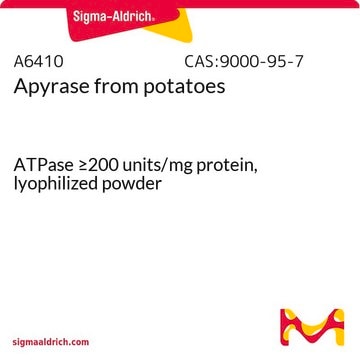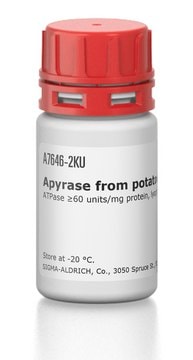A2230
Apyrase from potatoes
High Activity, ATPase ≥600 units/mg protein, lyophilized powder
Synonym(s):
Adenosine 5′-diphosphatase, Adenosine 5′-triphosphatase
Sign Into View Organizational & Contract Pricing
All Photos(1)
About This Item
CAS Number:
MDL number:
UNSPSC Code:
12352204
NACRES:
NA.54
Recommended Products
biological source
potato
Quality Level
form
lyophilized powder
quality
High Activity
ATPase activity
≥600 units/mg protein
secondary activity
≥50 % of base activity ADPase
composition
protein, ≥30%
foreign activity
Acid Phosphatase ≤2% of base activity
shipped in
wet ice
storage temp.
−20°C
Looking for similar products? Visit Product Comparison Guide
Application
Apyrase is used to hydrolyze nucleoside triphosphates and diphosphates. Apyrase, from Sigma, has been used in inhibition studies of platelet-aggregation . Product A2230 is a high activity apyrase.
At least two isoenzymes are found in different varieties of S. tuberosum: one with a high ATPase/ADPase ratio (∼10) and another with a low ratio (∼1).
Reaction: ATP → ADP+Pi → AMP+2Pi.
Reaction: ATP → ADP+Pi → AMP+2Pi.
Biochem/physiol Actions
Apyrase is found in all eukaryotes and some prokaryotes. Apyrase, from potato, has a crucial role in regulating growth and development. Apyrase is involved in the inactivation of synaptic ATP as a neurotransmitter following nerve stimulation and in the inhibition of ADP induced platelet aggregation to prevent thrombosis . Divalent metal ions are required for activity and best activity is observed with calcium ion at 5 mM.
Packaging
Sold on the basis of ATPase units.
Unit Definition
One unit will liberate 1.0 μmole of inorganic phosphate from ATP or ADP per min at pH 6.5 at 30 °C.
Physical form
Lyophilized powder containing potassium succinate buffer salts.
Preparation Note
Derived from red potato
Signal Word
Danger
Hazard Statements
Precautionary Statements
Hazard Classifications
Resp. Sens. 1
Storage Class Code
11 - Combustible Solids
WGK
WGK 3
Flash Point(F)
Not applicable
Flash Point(C)
Not applicable
Choose from one of the most recent versions:
Already Own This Product?
Find documentation for the products that you have recently purchased in the Document Library.
Customers Also Viewed
Moritz Schmelzle et al.
Transplantation, 95(1), 63-69 (2012-12-13)
We have previously demonstrated that CD133 and CD39 are expressed by hematopoietic stem cells (HSC), which are mobilized after liver injury and target sites of injury, limit vascular inflammation, and boost hepatic regeneration. Plasma microparticles (MP) expressing CD39 can block
Joanne S J Chia et al.
Journal of biomedicine & biotechnology, 2012, 320495-320495 (2012-11-03)
Diabetes mellitus encompasses two distinct disease processes: autoimmune Type 1 (T1D) and nonimmune Type 2 (T2D) diabetes. Despite the disparate aetiologies, the disease phenotype of hyperglycemia and the associated complications are similar. In this paper, we discuss the role of
David W Rooklin et al.
Journal of the American Chemical Society, 134(37), 15595-15603 (2012-08-30)
Human soluble calcium-activated nucleotidase 1 (hSCAN-1) represents a new family of apyrase enzymes that catalyze the hydrolysis of nucleotide di- and triphosphates, thereby modulating extracellular purinergic and pyrimidinergic signaling. Among well-characterized phosphoryl transfer enzymes, hSCAN-1 is unique not only in
Martina Nowak-Machen et al.
American journal of respiratory cell and molecular biology, 48(5), 601-609 (2013-01-26)
Critically ill patients are routinely exposed to high concentrations of supplemental oxygen for prolonged periods of time, which can be life-saving in the short term, but such exposure also causes severe lung injury and increases mortality. To address this therapeutic
Jing Wu et al.
Investigative ophthalmology & visual science, 53(11), 7142-7148 (2012-09-22)
To investigate the mechanisms for endogenous production of extracellular adenosine in trabecular meshwork (TM) cells and evaluate its physiological relevance to the regulation of aqueous humor outflow facility. Extra-cellular levels of adenosine monophosphate (AMP) and adenosine in porcine trabecular meshwork
Our team of scientists has experience in all areas of research including Life Science, Material Science, Chemical Synthesis, Chromatography, Analytical and many others.
Contact Technical Service














